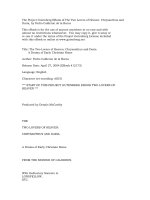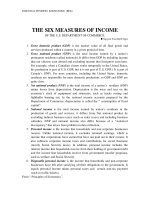Terrible exible the last days of napoocon
Bạn đang xem bản rút gọn của tài liệu. Xem và tải ngay bản đầy đủ của tài liệu tại đây (7.23 MB, 273 trang )
Free ebooks ==> www.Ebook777.com
www.Ebook777.com
Free ebooks ==> www.Ebook777.com
T e r r i b l e Exile
www.Ebook777.com
Terrible Exile.indd 1
1/20/2010 3:04:32 PM
Sir Brian Unwin studied at the universities of Oxford and Yale. After a
career in the civil service in Whitehall he became President of the European
Investment Bank. He has a long-standing interest in the Napoleonic period
and Napoleon’s captivity on St Helena and in 2007 visited the island in
pursuit of his research into Napoleon’s captivity there.
Terrible Exile.indd 2
1/20/2010 3:04:32 PM
T e rrible Exile
The Last Days
of Napoleon on
St Helena
Br i a n Unwin
Terrible Exile.indd 3
1/20/2010 3:04:32 PM
Free ebooks ==> www.Ebook777.com
Published in 2010 by I.B.Tauris & Co Ltd
6 Salem Road, London W2 4BU
175 Fifth Avenue, New York NY 10010
www.ibtauris.com
Distributed in the United States and Canada Exclusively by Palgrave Macmillan,
175 Fifth Avenue, New York NY 10010
Copyright © 2010 Brian Unwin
Line drawings and maps copyright © 2010 Mike Unwin
The right of Brian Unwin to be identified as the author of this work has been asserted
by him in accordance with the Copyright, Designs and Patents Act 1988.
All rights reserved. Except for brief quotations in a review, this book, or any part
thereof, may not be reproduced, stored in or introduced into a retrieval system, or
transmitted, in any form or by any means, eletronic, mechanical, photocopying,
recording or otherwise, without the prior written permission of the publisher.
ISBN 978 1 84885 287 7
A full CIP record for this book is available from the British Library
A full CIP record is available from the Library of Congress
Library of Congress Catalog Card Number: available
Typeset by JCS Publishing Services Ltd, www.jcs-publishing.co.uk
Printed and bound in Great Britain by CPI Antony Rowe, Chippenham
www.Ebook777.com
Terrible Exile.indd 4
1/20/2010 3:04:32 PM
C o nt en t s
˜˜˜
List of Illustrations
Map of St Helena
Plan of Longwood House in Napoleon’s Time
Preface
Principal Characters on St Helena
vii
x
xi
xiii
xvii
Introduction: The Lion or the Ass?
1 From Waterloo to Rochefort
2 The Journey from Rochefort to Plymouth
3 The Voyage to St Helena
4 Arrival at St Helena
5 Longwood House
6 The Arrival of Sir Hudson Lowe
7 Captivity and Confrontation
8 Napoleon’s Continuing Problems
9 Sir Hudson Lowe’s Problems
10 The Road to the End
11 A Judgement
Epilogue
1
10
31
46
56
72
87
97
117
142
162
183
197
Notes
Select Bibliography
Picture Credits
Index
207
221
224
225
Terrible Exile.indd 5
1/20/2010 3:04:32 PM
Terrible Exile.indd 6
1/20/2010 3:04:32 PM
Il l u st r a t ions
˜˜˜
colour plates
1
2
3
4
5
6
7
8
9
10
11
12
13
14
15
16
17
Napoleon boarding the Bellerophon, 15 July 1815
First view of St Helena, December 2007
Jamestown harbour as Napoleon would have known it in 1815
Jamestown harbour, 2007
Napoleon gazing out to sea, with Sir Hudson Lowe and Major
Gorrequer looking on
Napoleon at Longwood dictating to Count de Las Cases
The pavilion at the Briars, where Napoleon stayed from October to
December 1815
The Briars pavilion, 2007 – now a small museum
Sandy Bay, with the rusting cannon barrels lying across the beach,
December 2007
Longwood House, front view, December 2007
Plantation House, the Governor’s official residence, December 2007
Napoleon working in the Longwood garden
Napoleon at Longwood being watched by British sentries
Napoleon on his deathbed, surrounded by his faithful companions,
5 May 1821
Fanny Bertrand and her children at Napoleon’s deathbed (detail)
Exhumation of Napoleon’s remains, October 1840
Napoleon’s tomb, Geranium Valley, December 2007
black and white plates
1 Napoleon on HMS Bellerophon, July 1815
2 Sir Hudson Lowe entering Napoleon’s study at Longwood
Terrible Exile.indd 7
1/20/2010 3:04:32 PM
viii
terrible exile
3 Napoleon with his close companions on St Helena, Generals
Bertrand, de Montholon and Gourgaud, and Count de Las Cases
and his son
4 Betsy Balcombe (later Mrs Elizabeth Abell), 1816
5 The corpulent Napoleon on St Helena, with the Briars in the
background
6 General and Mme Bertrand, with their youngest son, at Napoleon’s
tomb, Geranium Valley
7 Fanny Bertrand
8 Albine de Monthalon
9 Lieutenant-General Sir Hudson Lowe, Governor of St Helena
10 Rear-Admiral Sir Pulteney Malcolm, naval Commander at St
Helena, 1816–18
11 Major Gideon Gorrequer, Aide de Camp to Sir Hudson Lowe
throughout his stay at St Helena
12 Dr Barry O’Meara, Napoleon’s doctor from 1815 to July 1818
13 General Charles Jean Tristan de Montholon
14 General Gaspard Gourgaud
15 Count Emmanuel de Las Cases
16 Dr Francesco Antommarchi, Napoleon’s doctor from September
1819 until his death
17 Mt Pleasant House, December 2007; the home of Sir William
Doveton, to which Napoleon made his final excursion from
Longwood in October 1820
18 Louis Marchand (first valet)
19 Louis Marchand and Louis Etienne St-Denis, known as Mameluke
Ali (second valet)
20 A replica of the wooden aviary built for Napoleon in November/
December 1819 by his Chinese gardeners at Longwood, from which
all the captive birds escaped
21 Sketch by Captain Frederick Marryat of Napoleon on his deathbed,
May 1821
22 Napoleon’s funeral cortège on St Helena, 9 May 1821
23 The triumphal return of Napoleon’s remains to Paris, December
1840
Terrible Exile.indd 8
1/20/2010 3:04:32 PM
Free ebooks ==> www.Ebook777.com
˜˜˜
to D i a na
˜˜˜
www.Ebook777.com
Terrible Exile.indd 9
1/20/2010 3:04:32 PM
map of st helena
Terrible Exile.indd 10
1/20/2010 3:04:32 PM
plan of
longwood house
in napoleon’s
time
1. Verandah
2. Parlour/Billiard room
3. Salon
4. Dining room
5. Library
6. Napoleon’s study
7. Napoleon’s bedroom
8. Napoleon’s bathroom
9. Marchand’s room
10. Offices
11. Kitchen
12. Laundry
13. Servants’ quarters
14. Silver room
15. Pharmacy
16. Las Cases rooms
17. Orderly officer’s quarters
18. Montholon family rooms
19. Dr O’Meara’s room
20. General Gourgaud’s room
21. Dining room of Dr
O’Meara and orderly
officer
22. Captain Piontkowski’s
room
23. Servants’ dining room
Terrible Exile.indd 11
1/20/2010 3:04:33 PM
Terrible Exile.indd 12
1/20/2010 3:04:33 PM
P REF A CE
˜˜˜
My first hero was the Duke of Wellington. He was a public servant
of the utmost dedication and integrity – a ‘nimmukwallah’, who served the
King ‘with unfailing zeal and cheerfulness’ as long as he ate the King’s salt –
and probably the finest general Britain has ever had. He never lost a battle.
I avidly collected books about his great final victory, thanks to Blücher and
the Prussians, at Waterloo and often tramped over the battlefield when I
could escape from my own battles over the European budget in the Council
and Commission meeting rooms in Brussels.
The more I studied Waterloo, however, the more curious I became about
the fate of the defeated Napoleon. With some feeling of guilt at deserting
my first hero the emphasis of my research switched from the Duke to the
Emperor and I began to devour the memoirs of those who had shared or
witnessed his captivity on St Helena. My interest became an obsession and
I felt compelled to write about it, moved partly by the fact that although
there are thousands of books about Napoleon, there is relatively little
detailed coverage, at least in English, of this final period of his life.
The heart of the St Helena drama is the confrontation between Napoleon
and the British Governor, General Sir Hudson Lowe, who was sent out with
over 2,000 troops to ensure he did not escape. Although Andrew Roberts
in his Napoleon and Wellington dismisses the rows between Napoleon and
Lowe as no more than a ‘footnote to a footnote to history’, it is a fascinating
story. History has, however, been hard on Lowe. The French tradition casts
him as an out and out villain – a brutal jailor, who cruelly persecuted his
prisoner – and much of the British tradition is little kinder. I therefore set
out to judge how fair this verdict is and whether Lowe’s reputation could
be rehabilitated. I found it hard to do so entirely, but I came to believe that
for all his faults the balance should be struck more evenly in his favour.
My obsession became such that I had to visit St Helena to see the place
of Napoleon’s prison for myself. My wife and I accordingly went to the
Terrible Exile.indd 13
1/20/2010 3:04:33 PM
xiv
terrible exile
island in December 2007. It was an amazing adventure and I was able to
visit Longwood House, the Briars, Napoleon’s tomb in Geranium Valley,
and even Mount Pleasant House, where Napoleon made his last excursion
from Longwood in October 1820. I am most grateful to J.J.€Smith,
Trevor Magellan and Rebecca Cairns-Smith for facilitating our visits to
Longwood, the Briars and Mount Pleasant respectively; and also for the
kind hospitality of the Governor, Andrew Gurr, and Jean Gurr which
allowed us to explore his official residence, Plantation House, which Lowe
had occupied. As we walked through the corridors I could almost feel
the presence of Lowe’s aide de camp (ADC), Major Gideon Gorrequer,
as he sat alone in his small room each evening scribbling by candle light
his extraordinarily bitter diary of each day’s events. But the most dramatic
moment of the visit was our first sighting of the island from the good ship
RMS St Helena, as the distant dot on the horizon gradually transformed
into a mass of high, jagged, volcanic cliffs, like prison walls. I could just
begin to imagine Napoleon’s horrified feelings as he saw it for the first time
from the deck of the Northumberland on 15 October 1815.
Many people have helped and encouraged me, above all my wife, Diana.
In addition to the photographs she took on St Helena she read each chapter
as it emerged, making many valuable corrections and suggestions; she gave
particular help in compiling the notes and the index; but above all tolerated
patiently my incessant chatter about Napoleon, who somehow crept into
every conversation both at home and with friends. I also benefited greatly
from the professional advice and help of our eldest son, Michael, a talented
author, artist and editor himself, whose chapter heading illustrations adorn
this book. My sister-in-law, Dr Elspeth Adams, kindly gave me valuable
advice on Napoleon’s illness; and I was much helped by the librarian of the
Reform Club, Simon Blundell, who allowed me a long lease of crucial 19thcentury texts. Finally, I owe a great debt to my editor, Liz Friend-Smith,
for her faith in this project and her ever perceptive and constructive advice
when it came to organizing and licking it into shape; and also to Jessica
Cuthbert-Smith and copy-editor Steve Williamson for their expert help
in the final stages. Needless to say, however, any errors or failings of fact or
judgement are entirely mine.
I hope this book will be an interesting and enjoyable read and that, while
seeking to portray sympathetically the appalling circumstances in which
Napoleon ended his career, it will also correct the historical balance a little
Terrible Exile.indd 14
1/20/2010 3:04:33 PM
preface
xv
more in Sir Hudson Lowe’s favour. He certainly did not merit the shabby
treatment he received from the British Government after he returned from
St Helena ‘mission accomplished’. As Napoleon’s companion, General
Gourgaud, remarked: ‘Even if an angel had been sent out as Governor, it
would have been all the same.’
Terrible Exile.indd 15
1/20/2010 3:04:33 PM
Terrible Exile.indd 16
1/20/2010 3:04:33 PM
P r i n c ip al
C h a r acters on
St He lena
˜˜˜
Abell, Mrs Elizabeth: see Balcombe, Betsy.
Ali, Mameluke (1788–1856): Napoleon’s second valet, whose real name
was Louis-Etienne St-Denis. He entered Napoleon’s service in 1806 and on
being made ‘Second Mameluke’ in December 1811 (an appointment dating
back to Napoleon’s 1798 Egyptian expedition) became known as Ali. He
served Napoleon on many campaigns, including Russia and Waterloo, and
accompanied him in exile on both Elba and St Helena, where he remained
until Napoleon’s death one of his most loyal and trusted servants. His
memoirs, published for the first time in 1926, form a touching account of
his service. He was a member of the party sent to bring Napoleon’s body
back to France in 1840.
Antommarchi, Dr Francisco (1789–1838): a Corsican doctor who was
sent to St Helena in July 1820 by Napoleon’s mother, Madame Mère, and
his uncle, Cardinal Fesch. Although a skilled anatomist, who had studied
at Pisa and Florence, he had little experience of general practice and no
credibility with Napoleon. He nevertheless performed the autopsy on
Napoleon but, in a dispute with the English doctors present, refused to
sign the official report. He published his memoirs of that time in 1825 in
Les Derniers Moments de Napoléon.
Archambault, Achille Thomas L’Union, and Joseph Olivier: brothers,
who were coachman and groom respectively to Napoleon on St Helena.
Achille remained until Napoleon’s death and returned in 1840 for the exhumation. Joseph was expelled by Sir Hudson Lowe in October 1816 but later
found service with Napoleon’s elder brother, Joseph, in the United States.
Terrible Exile.indd 17
1/20/2010 3:04:33 PM
xviii
terrible exile
Arnott, Dr Archibald (1771–1855): surgeon to the 20th foot regiment,
he came to St Helena in April 1819 and paid his first professional call on
Napoleon in April 1821, shortly before his death. They quickly established a
good rapport and he attended Napoleon until his death and was present at
the autopsy. In 1822 he published An Account of the Last Illness of Napoleon,
which upset Sir Hudson Lowe.
Balcombe, Betsy (1802–71): Betsy was the younger daughter of William
and Jane Balcombe and became a great favourite of Napoleon during his
stay at the Briars. Under her married name, Mrs Abell, she published in
1844 To Befriend an Emperor, a delightfully fresh and lively account of her
relationship with Napoleon.
Balcombe, William (1779–1829): superintendent of public sales for the
East India Company on St Helena and official purveyor to Longwood. He
went to St Helena in 1807 and he and his wife, Jane, established a cordial
relationship with Napoleon during the latter’s stay in a pavilion in the
garden of the Briars, from October to December 1815. After Napoleon’s
move to Longwood they were frequent visitors there but Sir Hudson
Lowe caused Balcombe to leave the island in March 1818 on suspicion of
abetting Napoleon in clandestine correspondence and for other alleged
irregularities. He was later rehabilitated and appointed Colonial Treasurer
of New South Wales, where he died in 1829.
Balmain, Alexandre Antonovitch Ramsay, Count de (d.1848): the
Russian Commissioner, who arrived on St Helena in June 1816 and left in
May 1820, having married Sir Hudson Lowe’s elder step-daughter. He was
generally supportive of Lowe’s policies and conduct.
Baxter, Dr Alexander (1771–1841): an army surgeon who had served in
the Corsican Rangers with Sir Hudson Lowe and been with him at the
surrender of Capri. At Lowe’s request he accompanied him to St Helena
as Deputy-Inspector of Hospitals and became closely involved in the
politics of the medical treatment of Napoleon in the weeks prior to his
death. After leaving St Helena he took a medical degree in Edinburgh and
became Chief Medical Officer in Barbados.
Bertrand, General Henri Gratien, Count (1773–1844): a military engineer
by training, Bertrand served with great distinction in many of Napoleon’s
Terrible Exile.indd 18
1/20/2010 3:04:33 PM
Free ebooks ==> www.Ebook777.com
principal characters
xix
campaigns and was appointed Grand Marshal of the Court in November
1814. He was with Napoleon in exile on Elba and present at Waterloo, and
followed Napoleon to St Helena, where he was the senior member of the
Longwood household and bore the brunt of Napoleon’s fraught relations
with Sir Hudson Lowe. Despite much provocation and pressure from his
wife to return to Europe, he served Napoleon with touching loyalty until
the end. He was a prominent member of the party sent to St Helena in
1840 to bring back Napoleon’s remains to France.
Bertrand, Fanny, Countess: daughter of General Arthur Dillon, an Irish
refugee, and well connected in London, she accompanied her husband,
under protest, to St Helena. A feisty character, she incurred Napoleon’s
displeasure by insisting on living separately from Longwood (initially at
Hutt’s Gate and later in a newly built cottage opposite Longwood). She
took three children with her and had a fourth on the island.
Bingham, Brigadier-General Sir George Ridout (1776–1833): having
served with distinction in the Peninsular War he was appointed to command the troops on St Helena and travelled there on the Northumberland
with Napoleon and his party. He remained on the island until May 1820
and enjoyed a friendly relationship with Napoleon.
Buonavita, Abbé Antonio (b.1753): he was sent out in September 1820 by
Napoleon’s uncle, Cardinal Fesch, to serve as his priest. He was, however,
elderly and infirm, and after a miserable and unproductive time returned to
Europe in March 1821.
Cipriani (d.1818): his full name was Cipriani Franchesci but he was always
known only by his first name. He served as maître d’hôtel at Longwood
and as a fellow Corsican was particularly close to Napoleon. He died
mysteriously on 26 February 1818 after developing severe stomach pains at
a dinner a few days previously.
Cockburn, Rear-Admiral Sir George (1772–1853): a distinguished sailor
who served in most theatres of the Napoleonic wars and was also involved
in the burning of Washington. He was chosen to convey Napoleon to St
Helena on the Northumberland in July 1815 and remained in command of
the forces on the island until the arrival of the new Governor, Sir Hudson
Lowe, in April 1816. He established good relations with Napoleon, who
www.Ebook777.com
Terrible Exile.indd 19
1/20/2010 3:04:33 PM
xx
terrible exile
regretted that he did not become the Governor. He left St Helena in June
1816, was promoted vice-admiral in 1819, full admiral in 1837, and First Sea
Lord in 1841.
Doveton, Sir William Webber (1753–1843): one of St Helena’s grandees,
and a member of the island Council. He was knighted for services to the
East India Company and St Helena during a visit to England in 1818–19.
On his last excursion from Longwood, on 4 October 1820, Napoleon visited Doveton’s house, Mount Pleasant, overlooking Sandy Bay, and had
breakfast with the family on the lawn.
Gorrequer, Major Gideon (1781–1841): Aide de Camp and acting Military Secretary to Sir Hudson Lowe, with whom he had served in Sicily and
the Ionian Islands. Although not the most senior of Lowe’s aides, he was
the closest to him and the most influential. He resided with the Lowes at
Plantation House throughout Napoleon’s detention, returning to Britain
with them in July 1821. Although a supporter of Lowe’s policies, he neverÂ�
theless bitterly resented the way Lowe treated him and gave vent to his
feelings in remarkably frank private diaries, which were not decoded and
published until 1968.
Gentilini, Angelo: an Elban who was a footman at Longwood and left the
island in October 1820.
Gourgaud, General Gaspard, Baron de (1783–1852): an artillery officer
who served in many of Napoleon’s campaigns, including Waterloo, and
claimed to have saved his life on two occasions. He was Master of the
Horse at Longwood and shared Napoleon’s dictation duties with fellow
‘evangelist’, Count de Las Cases. He was, however, intensely jealous of his
companions, even challenging General Montholon to a duel, and left St
Helena in unhappy circumstances in March 1818. Promoted to lieutenantgeneral and aide de camp to King Louis-Philippe, he was a member of the
exhumation party in 1840, which he described in detail in his memoir, Le
Retour des Cendres de l’Empereur Napoléon.
Hodson, Major Charles Robert George (1799–1858): an officer in the St
Helena Regiment and Judge Advocate of the island, known as ‘Hercules’
by Napoleon in view of his exceptional height. He was present at both the
funeral and the 1840 exhumation of Napoleon.
Terrible Exile.indd 20
1/20/2010 3:04:33 PM
principal characters
xxi
Jackson, Lieutenant-Colonel Basil (1795–1889): he went to St Helena
with Sir Hudson Lowe and was responsible for the repairs to Longwood
and the building of the Bertrands’ villa and Longwood New House. A
French speaker, he was frequently at Longwood and widely suspected
of an affair with Madame de Montholon. He left St Helena at the same
time as her in July 1819 and in 1877 published an account of his time there
in Reminiscences of a Staff Officer. When he died at the age of ninety-four
he was the last survivor of those connected with Napoleon’s captivity.
Lambert, Rear-Admiral Robert (1772–1836): in command of the St
Helena naval station from July 1820 to September 1821, he played little
part in the relationship between Sir Hudson Lowe and Napoleon and was
never, unlike his predecessors, received by Napoleon.
Las Cases, Emmanuel-Auguste-Dieudonné-Marius-Joseph, Count
de (1766–1842): in some ways the odd one out among Napoleon’s four
senior companions on St Helena. Of aristocratic background, his military
service was confined to a junior rank in the royalist navy, but he was the
author of the successful Atlas Historique, Généalogique et Géographique,
which Napoleon admired. A refugee in England during the Revolution,
he returned to France under an amnesty in 1802 and eventually became
chamberlain in Napoleon’s household. He accompanied him from Paris
to St Helena in 1815 and, as Napoleon’s principal amanuensis, became
very close to him. He was expelled by Sir Hudson Lowe in November
1816 for conducting clandestine correspondence for Napoleon but earned
great fame, and not a little reward, by publishing in 1823 the monumental
Mémorial de St Hélène, which glorified the Napoleonic legend and is an
important source on Napoleon’s first year in captivity.
Lowe, Lieutenant-General Sir Hudson, (1769–1844): a soldier from his
teens, Lowe served honourably in many campaigns and was responsible
for raising and commanding the Corsican Rangers, a regiment of dissident
Corsican rebels. In 1813 he was appointed liaison officer to the Russian
and Prussian armies and was highly rated by Marshal Blücher. He was
not present at Waterloo but in August 1815 he was selected by the British Government to become military governor of St Helena and Napoleon’s
jailor. He arrived there in April 1816 but his relationship with Napoleon,
who despised him, quickly broke down and Napoleon refused to see him
Terrible Exile.indd 21
1/20/2010 3:04:33 PM
xxii
terrible exile
again after only their sixth meeting in August 1816. He nevertheless continued as Governor until Napoleon’s death, and returned to London, mission
accomplished. He was, however, treated shabbily by the British Government, who used him as a scapegoat for popular criticism of the treatment
of Napoleon, and he was never again given an appointment commensurate
with his rank and seniority.
Malcolm, Rear-Admiral Sir Pulteney (1768–1838): a distinguished sailor
who had served throughout the Napoleonic wars, he arrived at St Helena
on 17 June 1816 to succeed Admiral Cockburn as Commander of the St
Helena Station. He made an immediately favourable impression on Napoleon and, with his wife – Clementina, a niece of Lord Keith – visited him
often. Although loyal to Sir Hudson Lowe his relationship with Napoleon aroused Lowe’s suspicion and jealousy and when he left the island in
June 1817 they parted on strained terms. Lady Malcolm’s diary, published in
1899, is an interesting account of their conversations with Napoleon.
Marchand, Louis-Joseph (1792–1876): Napoleon’s first valet, who joined
his household in 1811 and accompanied him throughout his campaigns and
exile on Elba and on to St Helena. He was the devoted servant par excellence
and before his death Napoleon made him an executor and beneficiary of
his will and appointed him a count. He went with the 1840 expedition to
recover Napoleon’s remains and his memoirs are an important source on
Napoleon and St Helena.
Montchenu, Claude Marin Henri, Count (1757–1831): the French Commissioner on St Helena, who arrived in June 1816 and left in July 1821 after
Napoleon’s death. A royalist of the old school, he was a somewhat comic
figure, respected neither by Sir Hudson Lowe nor by Napoleon, whom he
never met.
Montholon, General Charles Jean Tristan, Count de (1783–1853):
following a modest military career he joined the Empress Josephine’s
household and, after switching allegiance to the restored Louis XVIII,
returned to Napoleon after the escape from Elba and was promoted to
general shortly before Waterloo. He accompanied Napoleon to St Helena,
with his wife and son, Tristan, and remained until the end, becoming one
of Napoleon’s most trusted companions and principal executor of his will.
Terrible Exile.indd 22
1/20/2010 3:04:33 PM
principal characters
xxiii
Following Napoleon’s death he wrote his memoirs and, after involvement
in Louis-Napoleon’s abortive coup in 1840, ended his career as a deputy in
the National Assembly.
Montholon, Albine-Hélène, Countess de (1770–1848): wife of Count de
Montholon, she accompanied him to St Helena but left, with her recently
born child, Napoléone-Joséphine, in July 1819. It is possible that she became
Napoleon’s mistress and that the child was his.
Noverazz, Jean Abram (1790–1849): third valet to Napoleon; he was at
Longwood throughout the captivity and returned for the exhumation in
1840.
O’Meara, Dr Barry Edward (1782–1836): a native of County Cork, after
service as an army doctor he became surgeon on the Bellerophon, quickly
gaining Napoleon’s confidence. With British permission he accepted the
post of physician to Napoleon and established a close rapport with him
at Longwood. Sir Hudson Lowe’s suspicion of this relationship led to
his removal from St Helena in July 1818. O’Meara had his revenge with
the publication of his best-selling A Voice from St Helena in 1822, which
seriously damaged Lowe’s reputation. He subsequently became a founder
member of the Reform Club in London.
Plampin, Rear-Admiral Robert (1762–1834): in July 1817 he succeeded
Admiral Malcolm as Commander of the St Helena Station and remained
until July 1820. He was a strong supporter of Sir Hudson Lowe’s treatment
of Napoleon and as such out of favour with the latter. He caused controversy on St Helena by bringing out to the island a lady to whom he was not
married.
Poppleton, Captain Thomas William (1775–1827): of the 53rd regiment
and the first orderly officer at Longwood (from December 1815 to July
1817).
Reade, Lieutenant-Colonel Sir Thomas (1785–1849): after service mainly
in the Mediterranean he was chosen by Sir Hudson Lowe to accompany
him as his Deputy Adjutant General to St Helena. A strong supporter of
Lowe’s policies towards Napoleon.
Terrible Exile.indd 23
1/20/2010 3:04:33 PM
xxiv
terrible exile
Stokoe, Dr John (1775–1852): surgeon to the Admiral’s flagship Conqueror,
he was called to attend Napoleon on 17 January 1819 and saw him on five
occasions before 21 January. Sir Hudson Lowe accused him of breaking
the rules on contact with Napoleon and had him court-martialled and
dismissed from the service.
Stürmer, Barthelémy, Baron de (1787–1853): the Austrian Commissioner
on St Helena who arrived in June 1816 and left in July 1818. Like the other
two Commissioners he never met Napoleon.
Verling, Dr James Roche (1787–1858): Irish surgeon to the Royal Artillery
on St Helena, he was appointed to reside at Longwood to give medical aid
to Napoleon in August 1818. Napoleon refused to see him and he left the
island in September 1819. His diaries are a useful insight into this period.
Vignali, Abbé Ange: a Corsican priest, of little education, sent out by
Napoleon’s uncle, Cardinal Fesch, in September 1819. He was of little use
to Napoleon but conducted his funeral service and left St Helena on 27
May 1821.
Warden, Dr William (1777–1849): surgeon on the Northumberland, he
remained at St Helena until 19 June 1816 and often visited Longwood. His
Letters are an entertaining, if not wholly reliable, account of that time.
Wilks, Colonel Mark (1760–1831): the popular Governor of St Helena
under the East India Company until Sir Hudson Lowe’s arrival in April
1816.
Wynyard, Lieutenant-Colonel Edward Buckley (1780–1865): arriving in
St Helena in May 1816, he served as Sir Hudson Lowe’s military secretary,
but did not play an important part in the relationship with Napoleon.
Terrible Exile.indd 24
1/20/2010 3:04:33 PM









